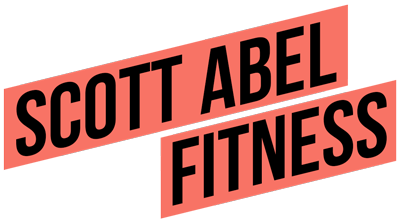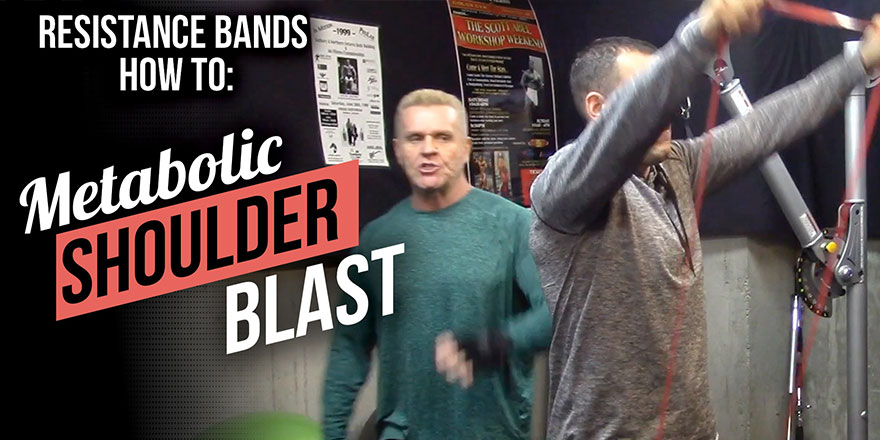This particular shoulder blast sequence was inspired by one of my recent trips to Aruba.
To put it diplomatically, the hotel where I prefer to stay in Aruba doesn’t have the best gym on the island. They have a “fitness room,” and it has an adjustable bench and dumbbells that go up to 50 lbs.
For shoulders, that’s often more than enough. So although I’d brought resistance bands, I didn’t think I’d need to use them.
I was wrong.
I was excited about going to the hotel tiny fitness facility and making use of the dumbbells for a simple workout that would hit all three heads of the delts. This meant a few side lateral raises, some front alternate raises, some dumbbell bent lateral raises, and —if my shoulders were up to it — maybe a one arm DB shoulder press for a limited ROM.
(With my advancing osteoarthritis in my shoulders, I have found that working out my shoulders actually helps me to reduce pain and to expand my range of motion. Obviously, however, I have to be careful.)
Usually, when the “fitness room” is empty, minus one or two people using the cardio equipment. (This is something I still don’t understand, since there are miles of pristine Caribbean beach right outside the doors!)
But, as luck would have it — though it didn’t seem that way at the time — there were a few other people using the fitness room when I arrive. One guy had all the dumbbells strewn all over the tiny dumbbell area. A complete mess. His “training partner” just sat on the only adjustable bench provided. They didn’t speak English, so the language barrier made asking to “work in” a more difficult option than usual. Also, I was on vacation, so I just wanted to get in, and get back out to the beach.
Now, normally, even this wouldn’t have been an issue, given that I had my resistance bands. But things got even more difficult, since the anchors I’d usually use (the fitness room has these big double emergency exit doors door handles that make great anchors) were no longer available—because how the two other trainees were spread out, a third person had put a yoga mat down and was doing yoga right near the doors. Since she was there first, I wasn’t about to be ‘that guy’ who just goes over and asks her to move.
I admit that at this point, I thought, “Oh well, no big deal. I’m on vacation.”
That certainly was a legitimate conclusion. A vacation is a vacation. Time off is important.
But in the back of my head was the little voice reminding me, “You’re a coach, and you can’t authentically advise anyone on what you don’t model in yourself.”
My first thought had actually been to just do a whole body workout, but as I warmed up to do some light overhead shoulder presses with the resistance bands, I realized I could do all the movements I wanted, all with just my flat band.
So… the metabolic shoulder blast was born. No dumbbells, no anchors—resistance bands only!
It was surprisingly simple and easy. It didn’t get in anyone else’s way and could do about five non-stop rounds in just half an hour or so. And the thing was, I almost didn’t want to stop there. I was “feeling it” so much I wanted to keep going; but, self-control got the better of me, and the beach beckoned.
Simple Metabolic Shoulder Blast
This sequence requires no anchor and can be done anytime/any place. Choose a flat resistance band with an appropriate level of tension for achieving a challenging and stimulating (but not grueling) 15-20 reps for all four exercises.
Check the video, but these are the kind of “flat resistance bands” I mean.
Also, just to be transparent: when I originally tried this sequence that first day, I used a round resistance with handles for my own side laterals variation at the end. But as I returned to the hotel room I smiled when I realized, wait… I could have done the whole circuit with just one flat band, and I could have done it right there in my hotel room!
The trick is that, once you get the right band, the exercise selection and sequencing and the use of different methods of anchoring the band man that you can get away with using a single band for exercises that otherwise require different amounts of tension.
Resistance Band Metabolic Shoulder Blast
- Standing RB Shoulder (Military) Press X’s 15-20 reps
- Standing RB 2-Arm Rear Delt Pull-a-Parts X’s 15-20 reps
- Standing RB 2-Arm Front Raises X’s 15-20 reps
- Standing RB Side Lateral Raises X’s 15-20 reps
* complete all exercises for a total of 3-4 rounds.
Explanation & How-To:
To get setup, place one side of the band under both feet to begin the first exercise in the sequence. This is your two-foot ground anchor.
Spread your feet as wide as you feel to create a desired tension level in the bands. Something as simple as foot width can create more or less tension for the exercise without a need for switching bands. And for some exercises you can employ a single foot anchor if desired, and that will change the tension level as well, which you will see.
Station #1: Standing RB Shoulder (Military) Press
Clean and press the bands overhead in a full military press lockout position; then, with arms full locked out, lower and perform military overhead press for 15-20 reps. Use foot spacing and placement to adjust the tension of the band.
Station #2: Standing RB 2-Arm RB Rear Delts Pull-a-Parts
Step out of the foot anchor position and slide one side of the resistance band to mid-point up the back and step forward into a staggered stance.
Since the band is now far less stretched because of how it’s behind your back, the tension should be appropriate for pull-a-parts. But, ust like you used foot spacing to create optimal tension in the band for the military press, now you can use hand spacing to create optimal tension for executing the rear delts pull-a-parts. Perform 15-20 reps.
Station #3: Standing RB 2-Arm Front Raises
Simply take one step back into a two-foot ground anchor and perform 2-arm front raises for the anterior delts for 15-20 reps.
Tip: Focus on reaching up and out in front in order to invite maximum fiber recruitment.
Station #4: Standing RB Side Lateral Raises
Now take one step out of the two-foot anchor to create a split stance with a single foot ground anchor. And from there perform 15-20 reps side lateral raises.
…and there you have it: simple and easy to execute resistance band metabolic shoulder blast.
The sequence begins with the big compound pressing movement, and from there it proceeds to target all three heads of the delts with the more isolated work. In keeping with one of the major tenets of my Innervation Training Methodology that means all three heads of your delts get hit in various ranges and planes of motion.
The combination of the sequencing and the use of this particular piece of equipment (flat resistance bands) has a few advantages:
- That’s why the pump you’ll get on this simple shoulder blast is insane.
- The use of bands and the exercise selection also means there is far less stress on the shoulder joints.
- You don’t have to wait for equipment or even slow down for making adjustments on equipment; you can just hang ‘em and bang ‘em without stopping.
Four exercises at 15-20 reps means that in each round you’ll hit your delts with 60 to 80 reps each round. Doing three rounds would mean a total of 180 to 240 reps!
These days trainees and experts alike tend to overlook and underestimate simplicity. But if you try this sequence, you’ll quickly appreciate that “simple” doesn’t mean easy! Unnecessary over-complication is the enemy of true expertise. As Einstein so aptly put it, “The truth is simple, and simplicity is the truth.”
Variation suggestions:
- An advanced trainee could also add shrugs to this sequence by keeping a two-foot anchor and reaching lower on the bands to create optimal tension; this would turn the sequence into a five-exercise monster protocol with virtually zero transition time.
- If you had a whole line of bands with you, yes, you could switch or experiment with band tension for each station in the circuit. Moreover, yes, you could just as easily do these exercises separately and one at a time as you would in a typical bodypart “shoulder day” workout. By adding more bands of varying tension you could also do more typical progressive resistance sets, or more tension and lower reps set to set in order to approximate a more traditional shoulder workout.
- Instead of just using a sequence like this as a stop-gap while travelling or on vacation, the above shoulder blast could be used on a separate day from shoulder workouts, in order to double up delts work. Since the bands create far less joint trauma, this is a great way to ‘add work’ without adding risk. This would be easy to do simply by employing this sequence to replace junk time volume many trainees devote to doing abs or cardio at the end of their bodypart workouts.
- For very advanced trainees- the above sequence could be employed as a ‘metabolic finisher’ to actual delts workouts. (For this kind of advanced application however, I would only recommend three rounds.)
- A similar application I like to use is to make a bodypart-specific circuit like this a “finisher” for a whole body workouts. IF you do this, leave out the shoulder exercise from the rest of the workout.
As you can see, when the design is simple, the productive program design applications can be endless!
Even ignoring the flexibility for traveling, convenience and storage, if you haven’t added resistance bands to your training tool box, then you’re missing out!
Stay tuned for more simple training solutions.

